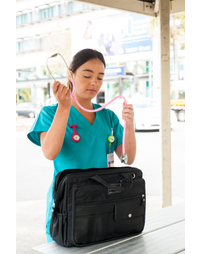Proper use of the stethoscope
eNurse talks, giving you practical tips to maximise your sound quality & which one to buy.
Most of us know the basics: you put the things in your ears, the other end on a sick person, and listen. But stethoscopes can do much more. Getting comfortable with your stethoscope will make you a better student and clinician.
Parts.
The following diagram will provide you with important vocabulary:
The most important parts to know are the diaphragm, which is larger, flatter side of the chest piece, and the bell, which has the smaller, concave piece with a hole in it. Switch between the two by twisting the chest piece 180 degrees. You'll hear a click. Then tap each side to see which one is "on."
How it works.
The diaphragm is a sealed membrane that vibrates, much like your own eardrum. When it does, it moves the column of air inside the stethoscope tube up and down, which in turn moves air in and out of your ear canal, and voila, you hear a sound. Since the surface area of the diaphragm is much greater than that of the column of air that it moves in the tube, the air in the tube must travel more than the diaphragm, causing a magnification of the pressure waves that leave the ear tip. In your ear, larger pressure waves make louder sounds. This is how stethoscopes amplify sounds.
Diaphragm vs. Bell.
The diaphragm is best for higher pitched sounds, like breath sounds and normal heart sounds. The bell is best for detecting lower pitch sounds, like some heart murmurs, and some bowel sounds. It is used for the detection of bruits, and for heart sounds (for a cardiac exam, you should listen with the diaphragm, and repeat with the bell). If you use the bell, hold it to the patient's skin gently for the lowest sounds, and more firmly for the higher ones.
Which one should I buy?
Stethoscope tubing typically ranges from about 18 to 27 inches (45 to 68 centimetres) long. Whichever brand or model you choose, think about the applications of our stethoscope when assessing your patient but also some practicalities for your comfort when not in use. Shorter, firm less flexible tubing, in theory, should help to amplify the sound but not too practical to hang around your neck. Lighter, longer and more flexible tubing is both practical and comfortable when carrying your stethoscope when not in use but may dimish the sound quality. Consider the weight of the headpiece. Stainless Steel is a great conductor of sound and considered the superior metal choice for the chest piece. There are alloys that also provide great sound distribution but without the weight of stainless steel. It's personal preference, as to what weight is comfortable to wear while not in use without losing quality of sound for assessment purposes.
How to wear it.
Place the ear tips in the ears, and twist them until they point slightly forward (toward your nose). If you do it right, you'll make a good seal, and sounds in the room will become very faint. Check out our YouTube channel eNurse tv for some practical tips to getting the most out of your stethoscope.
Remember
Clean your stethoscope regularly, particularly the chest piece. Studies have found that stethoscopes are frequently the vectors for patient-to-patient disease transmission. Just wipe the chest piece with an alcohol prep pad or disinfectant wipe.
Source:
https://science.howstuffworks.com/innovation/everyday-innovations/stethoscopes1.htm
https://www.sciencedirect.com/topics/medicine-and-dentistry/stethoscope





